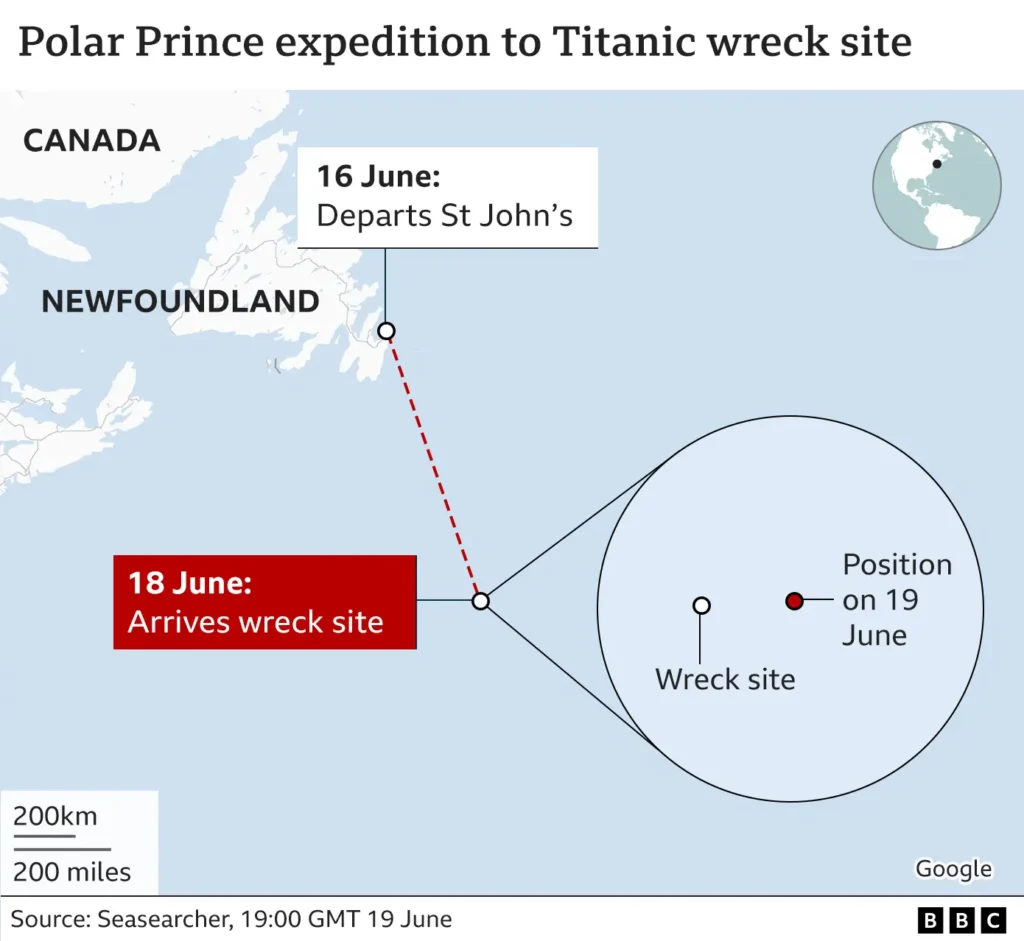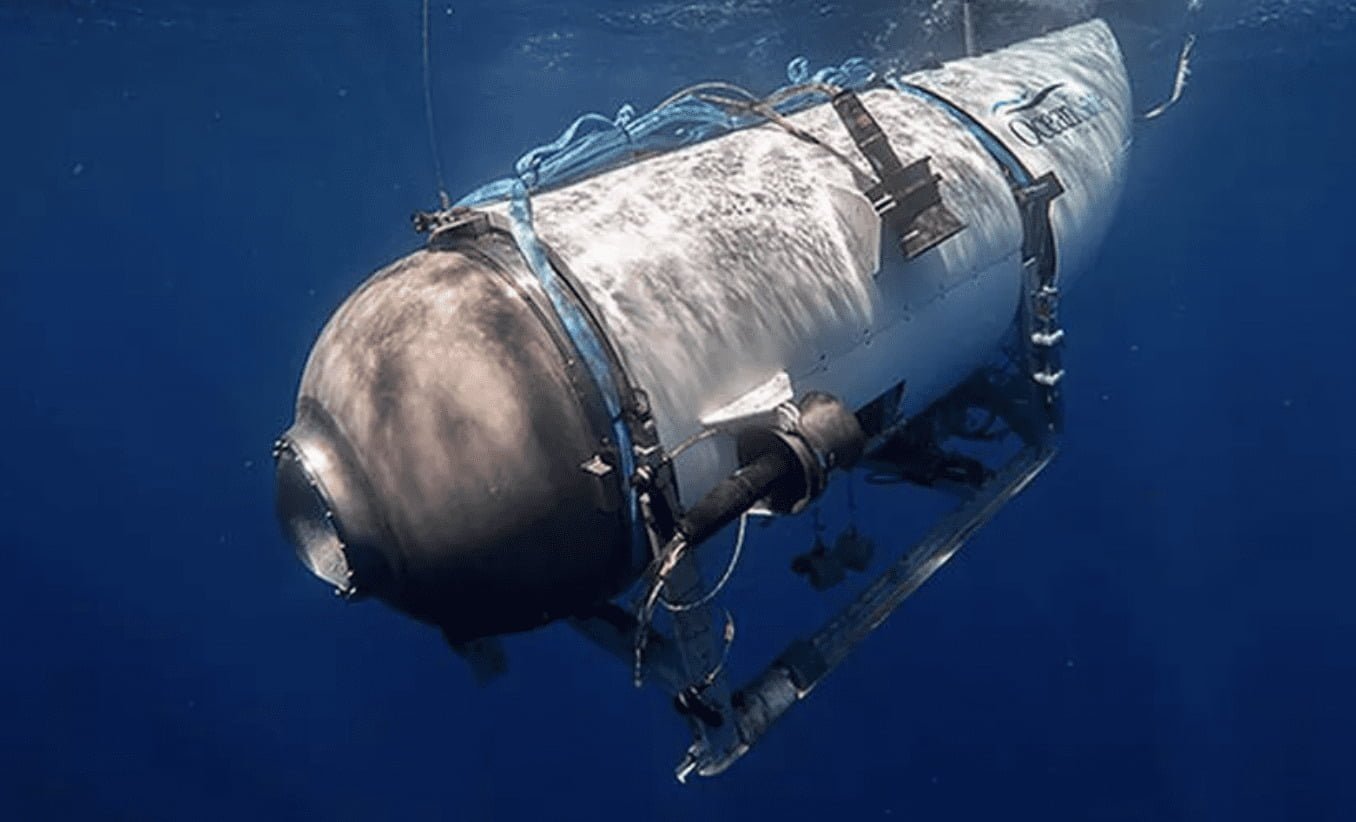The icy depths of the Atlantic have swallowed yet another vessel. This time, the famed Titanic tourist submarine and its crew of five have vanished into the dark waters. As the hours tick by, hope fades that the sub and its passengers will be found alive. But the families of the missing cling to the belief that their loved ones will be rescued. Scouring hundreds of miles, search crews strain to catch any sign of the bright yellow sub. But so far, all they’ve found is silence. Was this ill-fated voyage destined to mirror the Titanic’s tragic fate over a century ago? Keep watching the news as the search unfolds. The families of the missing need your prayers in this difficult time.
Titanic Submarine Missing During Dive
Crew Members Announced Missing
The five crew members on board the submersible have been confirmed as missing, according to tour company OceanGate Expeditions. The CEO of the company and his friend, two experienced former submariners, and an expert diver were aboard the sub. Their families have been notified, though search efforts remain ongoing.
Sub Suffered “Catastrophic Implosion”
The submersible was exploring the wreck of the Titanic, 2.5 miles below the surface. About 1 hour and 45 minutes into the dive, contact was lost with the surface vessel. Debris discovered on the seafloor indicates the sub suffered a catastrophic implosion at depth, destroying the vessel. The extreme pressures at that depth, roughly 8 tons per square inch, ultimately proved too much for the sub to withstand.
Massive Search Effort Underway
A huge rescue operation involving aircraft, ships, and submersibles from multiple countries has been searching the area of the Atlantic where the sub went missing. Sonar has detected noises that could potentially be signals from the emergency beacons aboard the sub, raising hopes that the crew’s remains or final moments might still be recovered. However, after four days, most experts say the likelihood of finding survivors is extremely small given the hostile conditions. The families of the crew have asked for prayers and privacy during this difficult time.
A Tragic End to a Historic Endeavor
The expedition was meant to conduct dives around the rapidly deteriorating wreck of the Titanic. Footage from earlier dives captured stunning images of the iconic shipwreck. Tragically, the quest to explore history led to the loss of five lives. Though commercial submersible travel has a good safety record, the immense pressures of the deep ocean remain an ever-present danger. The Titanic continues to claim victims, over a century after its doomed voyage into history.
What We Know So Far About the Missing Submarine
The Titanic-bound submarine went missing on Sunday during a dive to the wreckage site of the RMS Titanic. According to reports, the submersible suffered a “catastrophic implosion” at a depth of over 2 miles, tragically killing all five passengers on board.
The Search Area
The search area spans over 70,000 square kilometers (roughly two times the size of Connecticut), making the rescue operation extremely challenging. Debris and noises have been detected, confirming the submarine’s location on the seafloor. However, rough conditions have hampered recovery efforts. The submersible appears to be in one piece but is crushed by the immense pressure, ruling out the chances of survivors.
The Passengers
On board were two sub-pilots, a journalist, an entrepreneur, and a scientist. The victims hailed from the U.S., U.K., France and South Africa. Their families have been notified, though their identities have not yet been released.
The Submarine
The submersible was designed to dive up to 12,000 feet for recreational tourism. It has completed over 10 dives to the Titanic’s wreck site since 2018. The cause of the catastrophic implosion remains unknown and will be subject to an official investigation. Routine maintenance checks were performed before the fatal voyage, though the extreme depths surpassed the sub’s structural limits.
Recovery Efforts
The search area’s vast expanse and extreme depths pose safety risks for recovery crews. Robotic submersibles have been deployed to scan debris fields and locate the main wreckage. Once pinpointed, specialist deep-sea salvage equipment will be required to raise the submarine to the surface. The operation is estimated to take weeks given the logistical challenges. Loved ones anxiously await the recovery and analysis for closure. Our thoughts remain with the victims and their families during this difficult time.
Details on the Crew Members Onboard the Missing Titanic Sub

Stockton Rush
Stockton Rush was the owner and operator of OceanGate Expeditions, the company that organized the Titanic submarine tour. As an experienced submersible pilot, Rush acted as the captain of the sub. His passion for ocean exploration and sharing the wonders of the deep sea with others motivated him to start OceanGate Expeditions.
Paul-Henri Nargeolet
Paul-Henri Nargeolet, the co-pilot of the sub, was a highly experienced submersible pilot and director of the French Oceanographic Campaigns. Nargeolet had completed more than 3,000 dives, many of them to the Titanic wreck site. His expertise and familiarity with the Titanic made him an ideal candidate to guide tourists on safe explorations of the famous shipwreck.
Hamish Harding
Hamish Harding, a British businessman and pilot, joined the Titanic sub-tour to fulfill a lifelong dream of viewing the wreck. Harding was an aviation enthusiast who enjoyed adventure and pushing the boundaries of human achievement. Tragically, his quest for discovery ultimately led to his untimely death.
Shahzada Dawood and Suleman Dawood
Shahzada Dawood, a Pakistani-British businessman, booked the submarine tour as a surprise adventure for his son Suleman. Dawood hoped the trip would be an unforgettable father-son experience, but he could not have imagined the tragic outcome. Their deaths sent shockwaves through their tight-knit community, cutting short two lives brimming with potential.
The crew members onboard the ill-fated Titanic submarine tour were experienced explorers and novices alike, united by a shared curiosity to witness a relic of history firsthand. Though their lives ended in tragedy, their memory lives on as a sobering reminder of the unforgiving nature of the deep ocean. By venturing into the unknown, they displayed the same spirit of adventure and discovery as the passengers aboard Titanic over a century ago.
Timeline of Events Leading Up to the Sub’s Disappearance
1345 GMT: Communication lost
You’ve likely already heard the news that a tourist submarine went missing in the Atlantic Ocean four days ago during an expedition to the Titanic wreckage site. According to reports, the submersible descended around noon to begin its dive. However, merely 1 hour and 45 minutes after beginning its descent, communication was lost with the vessel. The submarine was scheduled to return to the surface by 1900 GMT, yet failed to appear, sparking concern.
1900 GMT: Sub scheduled to return, fails to appear
When the submarine did not return as expected in the evening, a distress call was issued and search and rescue efforts began immediately. The US Coast Guard has been leading the search in the region where the sub was last heard from, which is located about 400 miles off the coast of Newfoundland, Canada. However, after four days of intensive searching, only noises have been detected in the depths of the Atlantic, with no confirmed signs of the submarine or its passengers.
Thursday (22 June): Air supply on sub down to last hours
Today marks the fourth day since the submarine went missing. Unfortunately, according to experts, the available oxygen supply aboard the sub would have only lasted a maximum of 72 hours. This means that, if there were any survivors after the catastrophic implosion that likely occurred, their air supply would now be perilously low or fully depleted. The search continues with urgency in the hope of a miracle, though officials say hope is dwindling for the safe recovery of any passengers or crew.
The situation is dire and the families of those lost are understandably distraught. Our thoughts are with them during this difficult time as the search for answers and closure continues. Though the outcome looks grim, rescuers remain determined to locate the wreckage. We can only hope they can bring some small comfort to loved ones anxiously awaiting news.
Search Efforts Underway to Find the Missing Submarine
The U.S. Coast Guard has launched a massive search and rescue operation to find the tourist submarine that went missing in the Atlantic Ocean four days ago. You’ve likely seen the news reports and are following updates closely, hoping for the best but fearing the worst as time continues to pass.
An International Response
The search involves resources from the U.S. Coast Guard, the U.S. Navy, the Royal Navy, and commercial vessels in the area. Given the submarine only had 96 hours of life support, the coordinated effort is a race against the clock to search the designated area of the ocean floor. Initial search areas were 3,000 feet deep, but have now expanded to depths of up to 6,000 feet to account for potential drifting. The crews are using sonar and submersibles to try and locate the craft, which will be challenging given the immense area to cover and treacherous conditions.
Sounds Provide Hope and New Leads
On the fourth day of the search, hydrophone sensors picked up two distinct metallic noises in the search area, sparking hopes that they came from the missing submarine. The sounds have given search crews new motivation and guidance on where to focus their efforts. However, they have not yet located the craft or received any emergency signals, and still have no concrete evidence the submarine’s passengers are alive. As each hour passes, concerns grow that even if found, it may be too late. But for now, all anyone can do is wait, hope, and pray that a breakthrough will come soon.
The situation is harrowing and difficult, as you likely feel a mix of emotions ranging from worry to optimism and back again. All we can do is trust in the abilities of the search and rescue teams, lean on loved ones for support, and find comfort in knowing that everything possible is being done to locate the submarine and rescue any survivors. Stay strong – miracles do happen, and together we must continue to hope.
Possible Theories on What Happened to the Titanic Sub

Snagged on Fishing Net or Wreckage
According to Professor Boxall, it’s possible the submersible got entangled in abandoned fishing gear or debris from the Titanic wreckage itself, preventing it from surfacing. At depths of over 2 miles, the extreme pressure and cold could have caused critical systems to fail before the crew had a chance to free themselves. Though a dangerous possibility, the sub was designed to maneuver tight spaces, so this seems unlikely unless there are unseen complications.
Lost Communication
Rear Admiral Parry has suggested that a loss of communication is to blame for the sub dropping out of contact. At such depths, radio signals can be disrupted, and it’s possible a technical glitch prevented the sub from relaying its position. However, failsafes should have kicked in to automatically resurface the craft if communication was lost for a prolonged period. The crew also had emergency rescue beacons to deploy in case of a communication failure. With no distress signals and no sign of the sub breaching the surface, communication issues seem improbable.
Implosion
According to expert Gallo, the most probable explanation is that the submersible imploded under immense pressure, tragically killing all on board. At nearly 3 miles down, the sub was experiencing pressures over 6,000 PSI, enough to crush its frame like an aluminum can. Even with state-of-the-art subs, the forces at these extreme ocean depths can be unpredictable and deadly. An implosion would also explain the lack of communication, emergency beacons, and the sub failing to automatically resurface. Though a disturbing scenario, an implosion currently seems to be the most likely fate that befell the doomed crew.
Theories abound as the search continues for definitive answers on the sub’s disappearance. All we know for certain is that five souls have been lost to the deep, claimed either by the eternal darkness of the abyss or the bone-crushing power of the sea itself. Our thoughts go out to the loved ones still waiting in anguish for news of the missing sub and her intrepid crew.
Other Underwater Vessel Incidents Similar to This One
Sadly, the Titanic submarine disaster is not the first of its kind. Several other underwater vessels have experienced catastrophic failures over the years, though luckily with less tragic results.
Mir Submersibles
Russia’s Mir submersibles, active from the 1980s to 2000, had several close calls. In 1989, Mir-2 became entangled in communication cables at a depth of 350 feet, requiring emergency surfacing. The crew escaped unharmed. Four years later, Mir-1 collided with its support ship during recovery, damaging its hull. Though flooding occurred, the sub surfaced safely.
Deepsea Challenger
In 2012, director James Cameron’s Deepsea Challenger submersible malfunctioned during testing for his record-setting dive to Challenger Deep in the Mariana Trench. Hydraulic fluid leaks and software issues plagued the vessel, at one point causing it to lose power and communications for over 30 hours. Luckily, Cameron was unharmed, although the incidents highlighted the risks of deep submergence.
China’s Rainbow Fish
China’s state-of-the-art Rainbow Fish submersible, designed to reach depths of up to 20,000 feet, experienced a “mechanical malfunction” during its 2019 maiden voyage, according to Chinese officials. The vessel surfaced prematurely but the crew was safe. Little else is known about the incident, demonstrating the secrecy that can surround issues with this highly specialized craft.
While submarines and submersibles have advanced rapidly, the depths of the ocean remain an inherently dangerous environment for humans to operate in. As this tragic Titanic submarine disaster highlights, even the most cutting-edge technology is still prone to failure, and the unforgiving conditions of the deep sea allow little room for error. Our hearts go out to the families of the victims, even as we hope that continued technological progress may help prevent such catastrophes from happening again in the future.
Safety Concerns About Tourist Submarines
As an adventurous tourist, the idea of exploring the Titanic’s wreckage up close in a submarine likely sounds thrilling. However, these submersibles that take passengers to extreme depths of the ocean also come with extreme risks that are not always fully disclosed.
Lack of Certification
Many tourist submarines like the one that recently went missing are not certified for human occupancy at such depths, unlike most commercial submarines. OceanGate, the company operating the missing craft, was urged to certify their vehicles to ensure the highest safety standards were met before paying customers 3,800 meters down. Without this certification, there are concerns that critical safety factors could be overlooked.
Engineering Challenges
Operating at extreme depths requires highly complex engineering to withstand the immense pressures. As submarines descend, the water pressure increases dramatically. At the depth of the Titanic wreck, the pressure is over 3,800 pounds per square inch – that’s over 250 times the normal pressure at sea level! If any part of the submarine fails under these forces, the results could be catastrophic.
Limited Emergency Options
In the event of an emergency, options for rescue or escape are almost nonexistent at such depths. It would take hours for another submarine to reach the location, by which time oxygen supplies would likely be depleted. The extreme depth also means decompression would be required before surfacing, adding additional time constraints.
While exciting deep-sea adventures await, the inherent dangers of these tourist submarines cannot be ignored. Until stricter safety standards and certifications are put in place, the risks to human life remain unacceptably high. For many, the reward of witnessing the Titanic’s wreckage firsthand does not outweigh the serious risks involved in reaching it. If choosing to take the plunge, go in with your eyes open to the safety concerns of these uncharted depths.
FAQs on Missing Submarines: Your Top Questions Answered
The disappearance of the Titanic submarine and its crew has left many unanswered questions. Here are the most common questions people have been asking:
You’re probably wondering why the US Navy hasn’t declared the submarine officially lost yet. The military generally does not declare submarines as lost until an extended search effort has been exhausted or they have concrete evidence the submarine was destroyed. Until then, the sub is considered still on patrol. The families of the missing crew members are clinging to the hope that the submersible surfaced and is adrift, waiting to be found.
What do we know about the missing submarine so far?
The submersible was an experimental tourist submarine designed to take passengers to view the Titanic’s wreckage. It was reported missing on its first dive to the Titanic site. The crew of 3 were highly experienced submariners and marine experts. The sub has state-of-the-art safety mechanisms, so its disappearance is perplexing. The Navy detected noises that could indicate an implosion, but they have not yet located any debris. The search area spans over 600 miles, making the operation extremely challenging.
How long can the crew survive?
Modern submarines typically carry enough life support systems and supplies to sustain the crew for several weeks. However, the Titanic submarine was not built for long-duration missions. At a maximum, the crew might have resources for 96 hours. Given the time that has elapsed, survival is unlikely. The frigid, high-pressure environment of the deep ocean also poses life-threatening risks, even if the sub is intact.
What happens if the submarine is never found?
If the wreckage remains lost, the crew’s families may never get closure. The Navy will eventually call off the active search but continue monitoring for clues to the sub’s fate. The loss would also majorly blow to the nascent deep ocean tourism industry. New safety standards and regulations would likely be followed to prevent future tragedies.
For now, all we can do is hope and pray for the safe return of the crew. Our thoughts are with their loved ones during this difficult time. Please join us in sending positive thoughts their way.
Conclusion
You hold your breath, waiting for news. The fate of the missing sub hangs in the balance. Thoughts race through your mind about the lost souls onboard and their loved ones left behind. Clinging to hope, you check the latest updates hourly. Though the outcome remains uncertain, you know the families need strength and support during this agonizing time of uncertainty. Hold space for them in your heart, sending prayers across the dark waters. And though the future is unknown, have faith that the truth will be revealed in time.


















